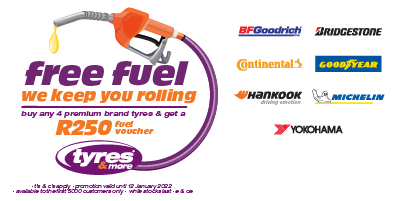If you`ve ever driven with a neurotic driver or compulsive last-minute-braker, your neck is probably twitching at the memory of your last near-whiplash experience. Automotive fitment centre chain, TYRES & MORE® is appealing to bad brakers with a message: “Stop it already!â€
Stop with the bad braking, that is. According to Marketing Manager, Natashe Taljaard, unless there`s an actual emergency, there`s no reason you can`t stop your vehicle without giving your passengers whiplash.
“Driving in general and braking in particular are about anticipation. If you observe the traffic around you and look ahead so you can anticipate your forthcoming stop, you`ll not only earn brownie points from passengers, but also dramatically increase the lifespan of your brakes and tyres,†said Taljaard.
So how exactly do you win “Braker of the Year†and take monthly brake pad changes off the budget?
“Most important is to brake smoothly. So, given that you`re now anticipating the timing of the traffic light ahead, you can apply gentle pressure to the brakes to achieve your goal of either stopping slowly at the red light, or slowing down enough that you can catch the change to green without coming to a complete stop,†advised Taljaard.
For even better braking, practise easing your foot gently off the brake before coming to a stop, so that the car glides to a halt with swan-like grace instead of nose-diving like a pelican.
Most new cars have ABS, a braking system designed to prevent your wheels locking when you brake so that you remain in charge of the direction the vehicle is travelling. If you haven`t experienced the shuddering associated with emergency braking with ABS, it will take you by surprise the first time. Most drivers react to their first experience of this by releasing the brake, but Taljaard warns that would be reckless.
“With emergency ABS braking, you want to keep your foot firmly depressed, regardless of the feedback you`re getting from the brake pedal,†she explained. “If you don`t have ABS, the technique is a little more involved. You want to brake firmly without actually slamming the brake, because that will lock the wheels. If the wheels do lock, simply release pressure for an instant then reapply pressure immediately.â€
Engine braking is another technique that separates the good from the bad brakers. As a rule this isn`t necessary in urban driving, but it`s useful when driving in the wet or negotiating long downhills. In such instances, selecting a lower gear and allowing the engine to slow the car down is preferable to skidding out in the wet or overheating the brakes on the downhills.
No matter how well you drive though, sooner or later your car will need new brake pads and discs, and when that happens you should have them fitted by a reputable fitment centre like TYRES & MORE®.





